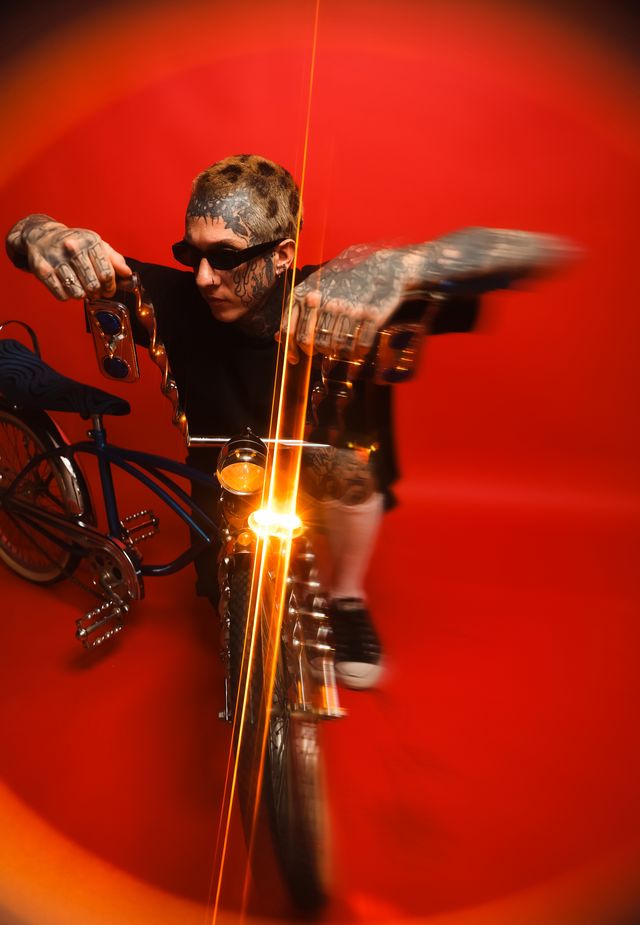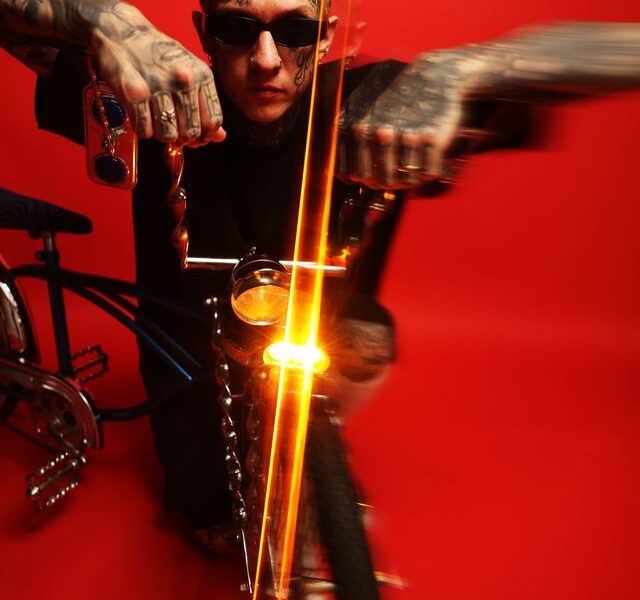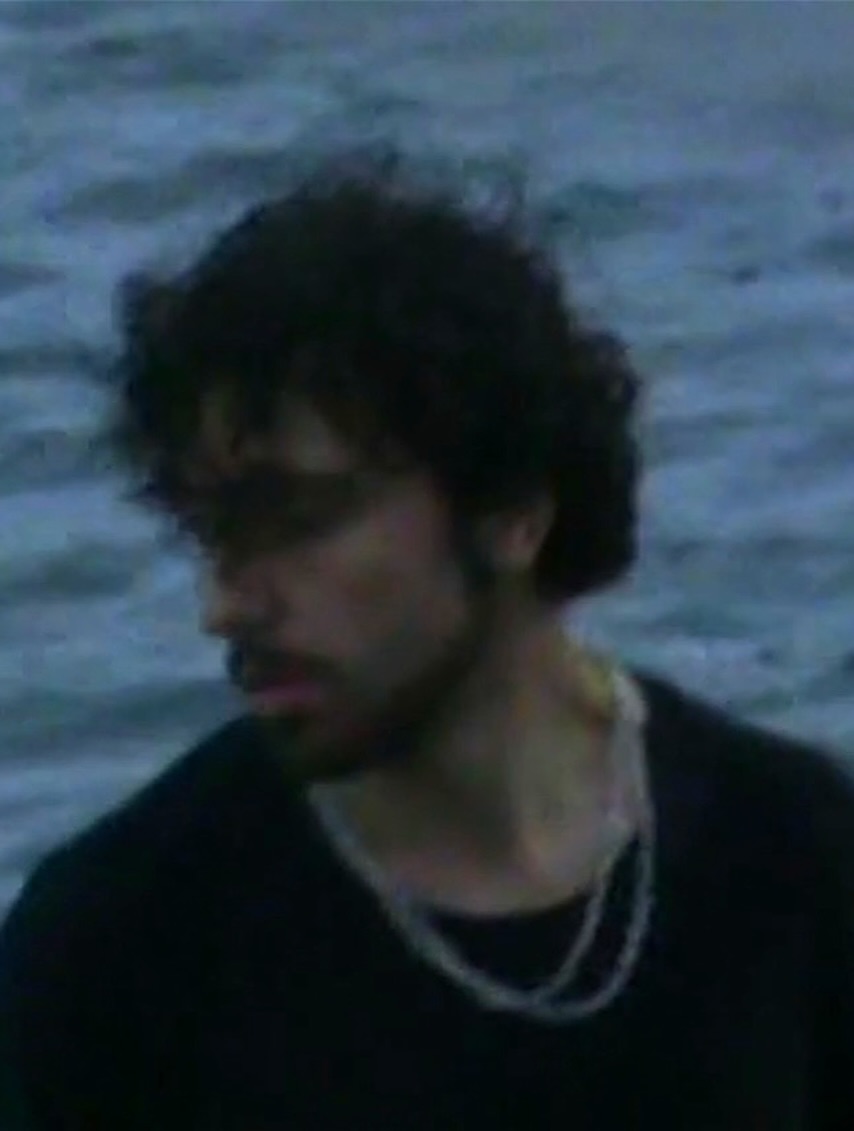GVLLOW has lived a few musical lives — drummer in punk bands, rapper, DJ, producer, and now, a frontman returning to his roots. The Riverside-born artist, known for blending punk aggression with gothic flair and hip-hop sensibility, is stepping into a new chapter with Laughing in the Dark, his upcoming album dropping this Halloween. The project is loud, raw, and deeply nostalgic, marking a homecoming both sonically and personally.
We caught up with GVLLOW to talk about his beginnings in Southern California’s punk scene, why staying true to yourself never goes out of style and his new album.
You started in music as a drummer in punk bands before anything else. What first pulled you into music—and what made you stay?*
“For me, it was actually my dad,” he recalls. “I was probably about five years old when he pulled out an acoustic guitar and played in front of me for the first time. It was like watching magic.”
By nine, GVLLOW wanted to play drums—something his father initially resisted, steering him toward guitar. But after hearing the thunder of drums in a nearby lesson room, he knew where his heart was. “I could hear the drums next door and thought, that sounds way more fun.”
Growing up in Southern California, he absorbed his environment. Blink-182 was exploding, and Travis Barker became a hometown hero. “Seeing someone like Travis, who looked like the older guys around me—tattoos, punk attitude—it was cool. That’s what made me want to be a drummer.”
By twelve, he was fully immersed in punk, going to shows at the legendary Showcase Theater in Corona and discovering his identity through music and rebellion. “It was just a mix of my dad’s influence and being a product of my environment. Once I started drumming in punk bands, I never stopped.”
Now you’re friends with Travis Barker—you’ve even released music with him and modeled for his brand. How did that happen?
“It’s crazy,” he laughs. “Travis is probably the most famous person I know, but he’s so humble and genuine. Just a solid dude.”
Their friendship started through mutual friends and social media. “I was DJing a lot in 2019, and we became mutuals on Instagram. I used to work for his brand, Famous, when I was 19—doing street team stuff, putting up stickers around my city. I sent him old photos from back then, and he remembered. Since then, we’ve just been cool.”
When Barker reached out recently to have him model again, GVLLOW didn’t hesitate. “Famous means a lot to me. It came from my area, and it’s part of my childhood. Travis will always be the homie.”
Has he taught you anything about life or music?
“He leads by example,” GVLLOW says. “When I was younger, I watched how he interacted with fans—so patient, so genuine. That stuck with me.”
He’s carried that energy into his own career. “Whenever someone wants to take a picture or tell me a song that means something to them, I really listen. I know what it feels like to be that fan. And Travis showed me that you don’t ever have to change who you are, no matter how big you get.”
Fashion seems to play a big role in your identity. Do you see it as another form of expression?
“Always,” he says without hesitation. “Even as a kid, I cared about how I dressed—not for other people, but for how I felt looking in the mirror. Even if I’m just going to the gas station, I want to feel put together.”
But his style isn’t about money or hype brands. “I don’t need a $5,000 pair of shoes. I wear Dickies, Ben Davis, Vans—simple stuff. My tattoos are already loud enough.”
Speaking of tattoos, do they tell your story?*
“It’s less about story and more about expression,” he explains. “I don’t get tattoos for other people to see—I get them because they make me feel good in my own skin. Every one of them connects to a memory or a moment in time.”
“Everything from my clothes to my music is about tailoring things to my liking.”
How has growing up in Riverside shaped you?
“Completely,” he says. “Riverside will always be home. My childhood was dirt bikes, tattoos, punk, hip-hop—it’s such a mix of cultures. That diversity plays a huge role in who I am.”
Music-wise, his early influences ranged from Limp Bizkit to Blink-182. “When I heard Limp Bizkit for the first time, it felt like discovering something that was mine. My mom hated it, which made me love it even more.”
At home, his parents had opposing tastes—his mom blasting Bon Jovi and Guns N’ Roses, his dad playing Neil Young and The Eagles. “It was like two worlds colliding, but I think that contrast shaped me creatively.”
How do you stay grounded in an industry that changes people so easily?
“My family keeps me grounded—my wife, my friends, my environment. And I stay focused on how I see myself,” he says. “When I was younger, I tried to fit in. I stopped dressing punk because I thought girls would like me more. But I was miserable. When I started being unapologetically myself, that’s when I felt happiest.”
You’ve moved through genres—punk, rap, goth—and now you’re back to a raw punk sound. What inspired this evolution?
“I’ve always bounced between sounds,” he explains. “Even when I was deep in punk, I loved rap. At that time, it wasn’t cool in the punk scene to like hip-hop, but I didn’t care.”
That open-mindedness shows up in *Laughing in the Dark*. “This is the first album where I played real drums again. Having that resource opened up a whole part of my brain. Suddenly the possibilities felt endless.”
Even now, rap still shapes his sound. “The cadences in my vocals—especially in the verses—come from hip-hop. Punk and rap are both about being yourself and letting go. That’s how I approached this record.”
Do you ever feel pressure to fit into a label—punk, goth, rapper—or do you reject labels altogether?
“There was a time I did,” he admits. “But not anymore. I don’t think about fitting in a box. Everything I do—tattoos, clothes, music—it’s all just what feels right to me. I don’t care about categories anymore.”

Your new album, Laughing in the Dark, marks a return to your roots. What inspired it?
“It’s a nostalgic record,” he says. “It’s inspired by my roots in Riverside, by dirt bikes, tattoos, skateboarding, punk rock—all of it. I wanted to capture the feeling of growing up here, surrounded by that mix of rebellion and culture.”
Do you have a favorite song from the album?
“‘Make It On My Own,’” he says instantly. “It’s got this fun groove—the tempo changes a lot. I just love the drums on it. I think people will be surprised to hear me play.
What can people expect from this new era?
“A lot of nostalgia,” he says. “For some people, it’ll feel brand new. For others, it’ll bring back memories they forgot about. I love that—reminding people of good times.”
If someone listens to this era of you for the first time, what do you hope they understand?
“I hope they know I’m being myself, 100%. I want them to hear a song and immediately know I’m from Southern California. I love where I’m from, and I’m proud to represent it.”
Any goals for this next chapter?
“I want this album to reach new people and inspire them to be themselves,” he says. “As cliché as it sounds, that’s what it’s all about. DIY or die—that’s my motto. If someone sees what I do and thinks, ‘I can do that too,’ then that’s everything.”
GVLLOW’s new album “Laughing in the Dark” drops this Halloween.


